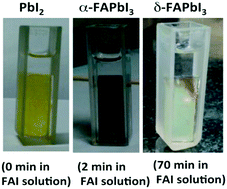Experimental evaluation of room temperature crystallization and phase evolution of hybrid perovskite materials†
Abstract
To overcome the problems of thermal, moisture and photo-stability of existing methylammonium based perovskites, formamidinium-based compositions are introduced for photovoltaic application. Formamidinium lead iodide (FAPbI3) and methylammonium lead bromide (MAPbBr3) mixed compositions of hybrid organic–inorganic perovskite type solar cells have shown the highest efficiency of 22.1%. For FAPbI3, two different polymorphs exist at room temperature: one is the hexagonal non-perovskite phase (δ-phase) and the other is the perovskite cubic phase (α-phase). The non-perovskite phase can be detrimental to the solar cell performance. To eradicate the undesired phase, a systematic evaluation of phase formation and crystallization is necessary. Here, we investigated the room temperature crystallization of the perovskite and non-perovskite phases of FAPbI3 by solvent and antisolvent induced crystallization methods using a two-step sequential deposition method. For each phase, the volume fraction is estimated using the X-ray diffraction technique. At room temperature, the δ-phase is found to grow as long one-dimensional nanorods and its volume fraction increases with the dipping time. It is observed that the presence of an antisolvent has a moderate control on the δ-phase growth. Experimentally, with the detailed solvent-induced time dependent crystallization study, we have proved the effective elimination of the δ-phase and the stability of the FA1−xMAxPbI3 perovskite phase.



 Please wait while we load your content...
Please wait while we load your content...